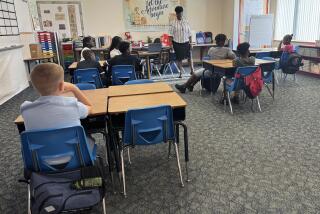Simmering Issue in Norwalk-La Mirada District : New Trustee Wants to Reopen Middle Schools
- Share via
NORWALK — Ever since the Norwalk-La Mirada Unified School District closed its intermediate schools nearly a decade ago, there have been those who have wanted them back, convinced that the district’s seventh- and eighth-graders are suffering in the elementary schools and high schools to which they were dispatched.
The lack of an intermediate level is an ever-flickering issue brought to the fore with last month’s election of Sal Ambriz to the school board. Ambriz promises to pursue the matter until he is “blue in the face.”
“It was constantly coming up,” Ambriz said, adding that during his neighborhood campaign walks he encountered widespread interest in reviving intermediate schools. “The constant cry I heard out there was that, ‘My kid is too old to go to elementary school,’ and ‘My child is too young to go to high school.’ ”
Ambriz, who will assume office with two other new board members next week, says he will lobby for a district study of the pros and cons of reopening separate schools for seventh- and eighth-graders.
The Norwalk-La Mirada district is unusual in maintaining a system of elementary schools for kindergarten through seventh grade, and high schools for eighth through 12th grades. The district’s six intermediates were phased out in 1978 as a way of dealing with declining enrollments. By keeping seventh-graders in the elementaries and sending eighth-graders to high school, the district boosted the enrollments of both, achieving more efficient use of those campuses.
“It was the easy way out,” recalled William Campbell, a new school board member who was a district administrator at the time. “They were the group of schools that had the least public support.” The intermediate schools, he said, never garnered the fierce alumni loyalty enjoyed by elementaries and high schools, making intermediate closings the least painful.
Although Campbell says an intermediate or middle school system is worthwhile, he does not believe the district will ever have the money to resurrect one. “The number of dollars it would take to do it are just not available. We’re struggling right now . . . I just can’t see it happening.”
Howard Rainey, the district’s business manager, estimates that it would easily cost $1 million to reopen a single intermediate school.
But Ambriz maintains that if the district really wants an intermediate school system, it can find the money to pay for it. He points, for instance, to the $9 million the district is getting from the sale of Wright School, one of the closed intermediates. Although the money is earmarked for other projects, Ambriz says the district could go back to the state Education Department and request permission to spend the income on revamping the five remaining intermediate facilities, which are either leased or being used for other district programs.
“Granted, we have financial problems. Granted, we have declining enrollments,” Ambriz said. “But other districts faced the same problems. They did not close the middle schools.”
Discontent with the district’s existing system centers on the placement of eighth-graders on high school campuses.
“My daughter was 12 years old when she started high school,” said Patricia Prieto of Norwalk, whose daughter Loretta Alvarez attends the eighth grade at John H. Glenn High School in Norwalk. “How do you expect someone of the age of 12 to mix in with someone who’s 15, or 16 or 17? . . . These kids are not mature enough to be in high school. They think they are, but they’re not.”
Sensitive to such concerns, the district has created what it calls a core program or “school within a school” for the eighth-graders at its three high schools. They are segregated from upperclassmen on a separate section of campus, given their own set of teachers, and kept in groups. The intention is to provide an environment that borrows from both the elementary and high school treatment of students.
“We did it because we saw they (eighth-graders) were not being successful in high school. They were getting lost. It was very difficult for them,” said Elias Galvan, principal of John Glenn, which two years ago also started a similar program for ninth-graders.
The core program does help, said Jackie Jackson of Norwalk, the mother of another John Glenn eighth-grader. But, she said, “you can’t segregate them. They’re on the same grounds.” It would be far preferable, she continued, if each set of grades had its own schools.
Jackson’s 13-year-old daughter, Brandi, said eighth-graders fight with upperclassmen, cut classes at the encouragement of upperclassmen, and in the case of girls, go out with upperclassmen. “We’re always with the older kids, practically,” she commented.
Even in the elementaries, Prieto said, there are problems with seventh-graders harassing younger students.
Declining enrollment also prompted the nearby Bellflower Unified School District to shut its intermediate schools in 1980. But in contrast to Norwalk-La Mirada, Bellflower administrators chose to send their seventh- and eighth-graders to high school, where they are kept in their own core program.
Bellflower Supt. Kenneth L. Davis said the district adopted the “school within a school approach” for the seventh- and eighth-graders two years ago, both because the older students were being distracted by the younger pupils, and because parents of the younger students worried that their children were mixing with upperclassmen who would lead them astray.
“There was no way we could convince them that there was no real big problem,” said Davis, who maintains that the parental concerns spring more from fears than actual difficulties.
More to Read
Sign up for Essential California
The most important California stories and recommendations in your inbox every morning.
You may occasionally receive promotional content from the Los Angeles Times.











